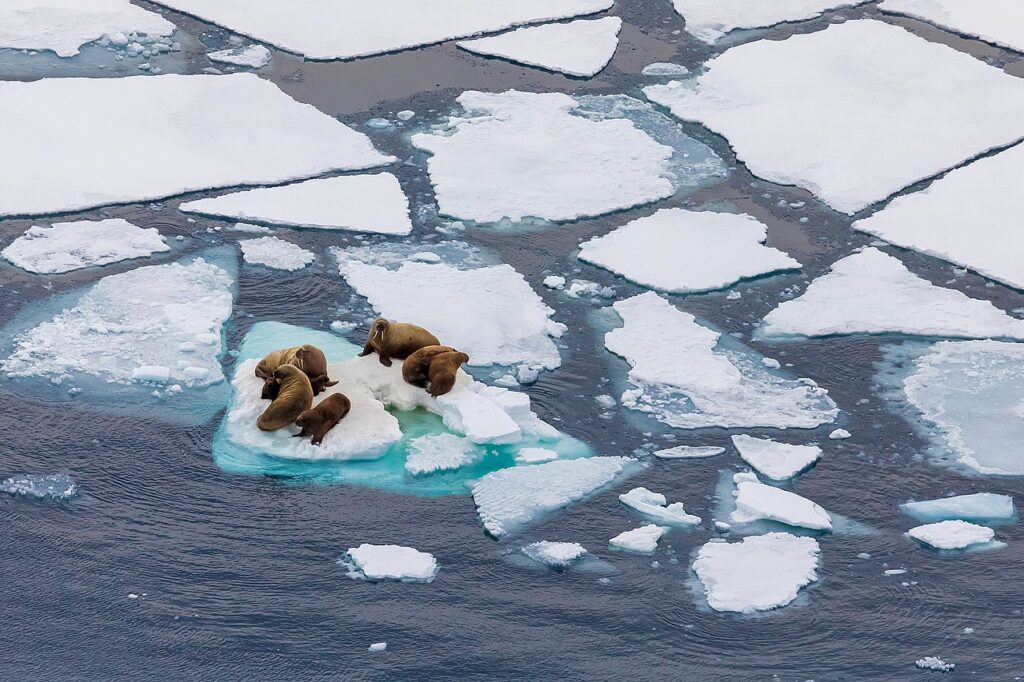The marine ecosystem features a distinct, complicated food web shaped by its unique plankton, animal species, and environmental conditions. Specifically the arctic ecosystem being one of the most inaccessible areas in the world, limiting our potential reach. It has an extreme climatic condition supporting varied and a unique biodiversity adapted to this extreme conditions.
Ranging from majestic Polar bear to the small fishes and aquatic invertebrates etc. sharing the same ecosystem with specified ecological niches. Although the Arctic is gaining popularity worldwide as a tourism and wildlife-watching destination, the region has always been vital to the identity, culture, and survival of its indigenous people.
A specific interaction between the biotic and abiotic factors and communities giving rise to a complex food chain and a habitat most susceptible to changes and destruction due to rising anthropogenic pressures. The vulnerability of the species inhabiting the dynamic ecosystem puts the immense biodiversity in the risk of extinction and global threat. The impact of climate change associated with the unsustainable and greedy human activities have led to major changes in the natural environmental compositions with increased pollution and ecological bio-contamination.

What are some threats to Arctic’s Marine Ecosystem?
Even the extremest places such as Arctic are also not left untouched of man-made pressures and are rapidly losing several endemic species. The rising levels of global warming has led to melting of huge glaciers and ice caps on which several biological entities are dependent. The changes in the oceanic composition due to high levels of acidification and organic by-flows are impacting the aquatic fragile ecosystem and its biota.
Rising infrastructural and technological development being a boon for humans has evolved as a bane for the natural world and the creatures dwelling therein.
The condition of a vital ecosystem like Arctic and its detrimental state needs to be immediately checked upon so that a global networking can be set to tackle and mitigate this ecosystem from degrading further. The impact of destruction to these key areas ultimately will affect the survival of we humans on Earth and thus needs to be monitored and controlled as soon as possible through proper collaboration and awareness initiatives for a global cause.
How can the Arctic’s Marine Ecosystem be conserved?
- Building a comprehensive scientific data base and coordinated monitoring program on the state of Arctic ecosystems.
- Establishing a mechanism to facilitate a cooperative approach towards conservation by introducing a participatory approach.
- Assessing the Impact of Hazardous environmental contaminants due to their high stability and persistence in the environment, potential for bioaccumulation and high chronic toxicity, and the large quantities which have been released into the environment.
- Recording the contaminants (Chlorinated organic contaminants) present in the arctic food chain at different trophic levels.
- Available information on ambient oil pollution in the Arctic is scarce. Developing methods and techniques for constraining and cleaning up oil spills from water and ice.
- Moving sound sources, notably boats and aircraft, seem to be more disturbing than stationary sources, e.g. dredges and drillships. The effects on fish and wildlife of cumulative exposure to noise are largely unknown. Gathering data on this aspect.
- Assessing the impact of radioactivity upon key mammalian species in Arctic.
- Understanding the effects of acid deposition on the Arctic ecosystem.
- Promoting the involvement of major stakeholders. Organising workshops for public awareness and gathering expert support.
- Introducing a broader scale collaborative approach involving the support from major industrial sectors towards Arctic conservation.
How is climate change impacting the Arctic?
The Arctic Ocean is different from other oceans in that it receives a large quantity of river input compared to its size, and fresh water has a low alkalinity or buffering capacity, (Ryan Woosley), which has limited the Arctic Ocean’s ability to absorb Carbon-dioxide.
Manizza pointed out that the Arctic Ocean’s temperature is rising at a significantly higher rate than the rest of the world’s waters. Changing temperatures are also linked to a slew of other changes, including: Sea ice is disappearing, reducing a barrier between the ocean and the wind, perhaps affecting ocean stratification. Warmer temperatures and changes in ocean stratification may have an impact on the number and types of primary producers that can live in the ocean. All of these elements may have an impact on the amount of CO2 that the Arctic Ocean can take from the atmosphere, either directly or indirectly.
Written by: Shreya Pandey
Conclusion
Help us help them! Think Wildlife Foundation is a non profit organization with various conservation initiatives. Our most prominent campaign is our Caring for Pari intiative. Pari is a rehabilitated elephant at the Wildlife SoS Hospital. 25% of the profits from our store are donated to the elephant hospital for Pari. Other than buying our wonderful merchandise, you could donate directly to our Caring For Pari fundraiser.
- MPIBGC/PH (2013). “Extreme meteorological events and global warming: a vicious cycle?”. Max Planck Research.
- ^ Tang, Ying; S. Zhong; L. Luo; X. Bian; W.E. Heilman; J. Winkler (2015). “The Potential Impact of Regional Climate Change on Fire Weather in the United States”. Annals of the Association of American Geographers. 105 (1): 1–21. doi:10.1080/00045608.2014.968892. S2CID 129057246.
- ^ Sahney, S.; Benton, M.J.; Ferry, P.A. (2010). “Links between global taxonomic diversity, ecological diversity and the expansion of vertebrates on land”. Biology Letters. 6 (4): 544–547. doi:10.1098/rsbl.2009.1024. PMC 2936204. PMID 20106856.
- ^ A. J. McMichael (2003). A. McMichael; D. Campbell-Lendrum; C. Corvalan; K. Ebi; A. Githeko; J. Scheraga; A. Woodward (eds.). Global Climate Change and Health: An Old Story Writ Large. World Health Organization. ISBN 9789241562485.
Thanking you.
